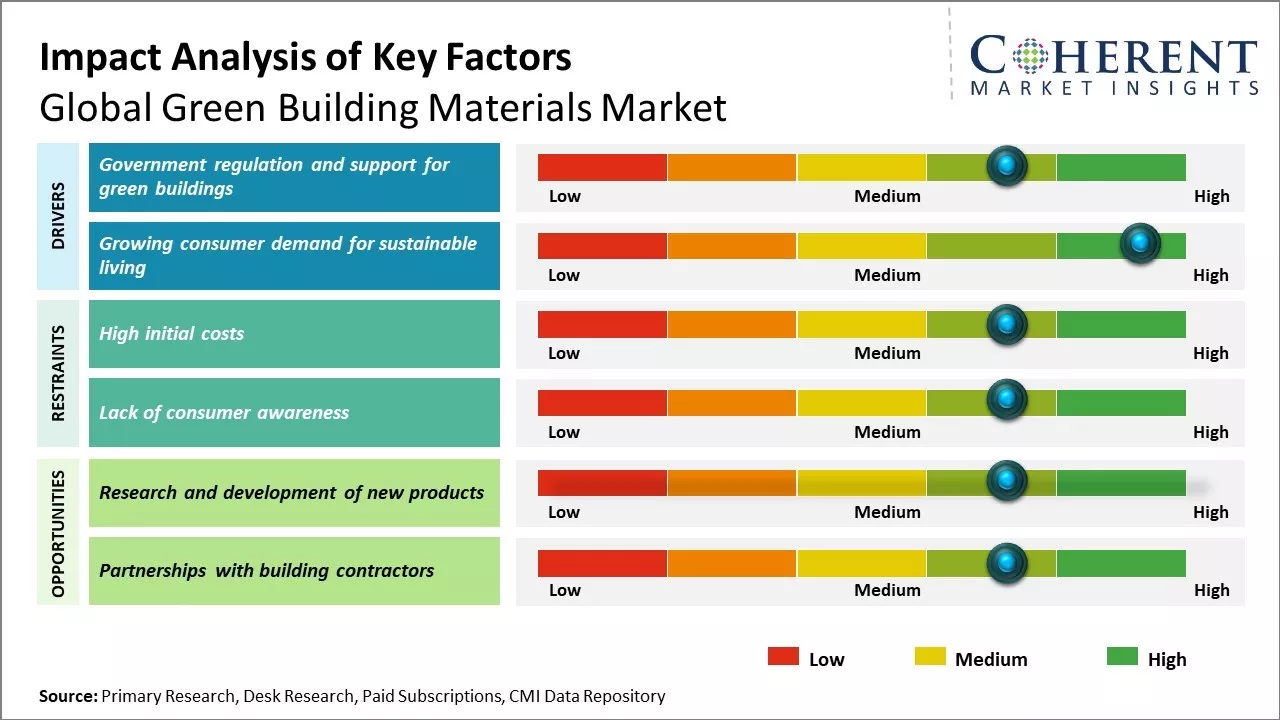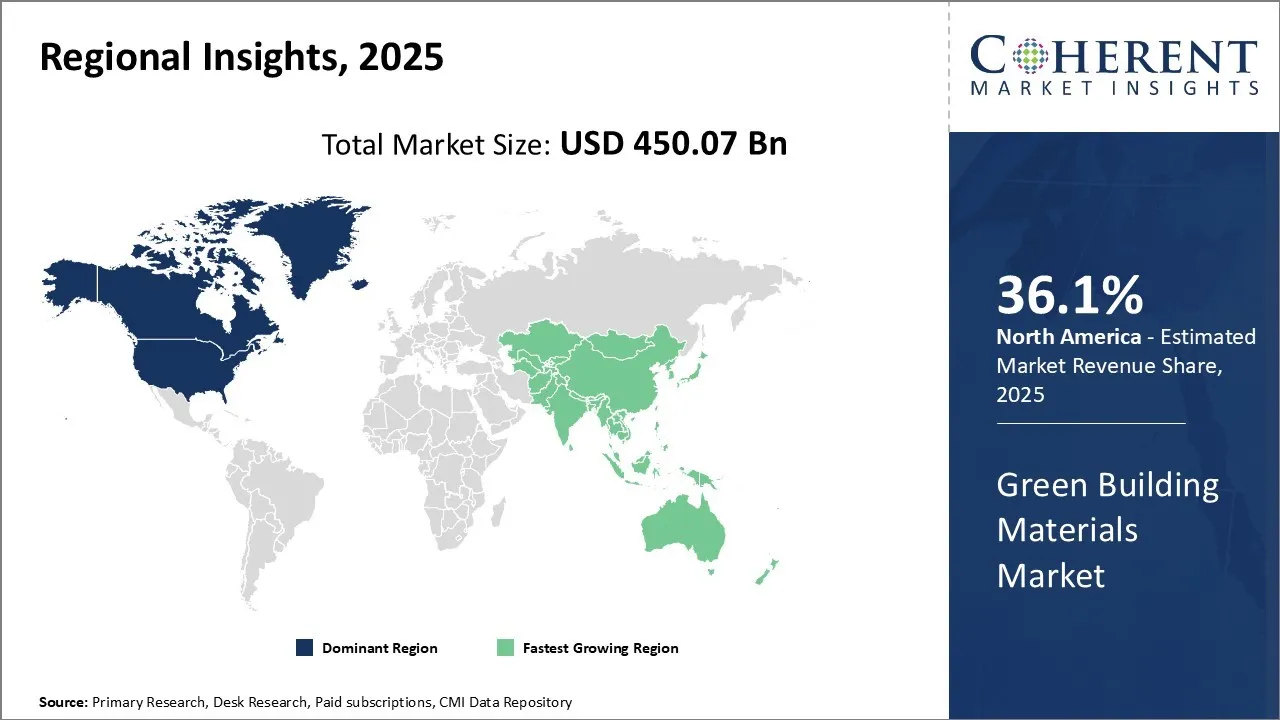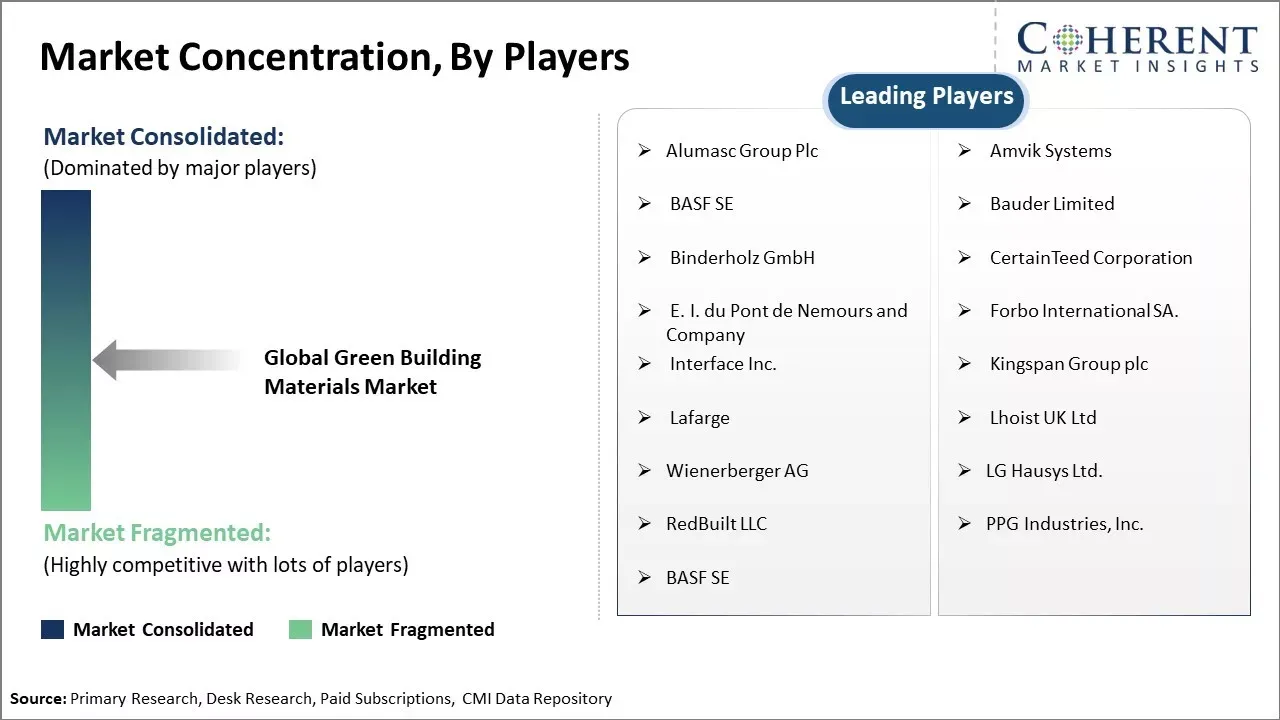The green building materials market is estimated to be valued at USD 450.07 Bn in 2025 and is expected to reach USD 1,014.40 Bn by 2032, exhibiting a compound annual growth rate (CAGR) of 12.3% from 2025 to 2032.

To learn more about this report, Download Free Sample
Government regulations and growing consumer awareness regarding energy efficient construction are driving increased demand for green building materials. The market is witnessing rising focus on sustainable construction globally. Buildings account for around 40% of the total energy consumption as well as carbon emissions. In order to reduce their environmental footprint, builders are increasingly adopting green building materials and technologies.
|
Current Event |
Description and its Impact |
|
Global Climate Policy Implementation and Net-Zero Commitments |
|
|
Technological Breakthroughs in Sustainable Construction Materials |
|
Uncover macros and micros vetted on 75+ parameters: Get instant access to report
Many governments around the world are actively supporting and incentivizing the use of green building materials through various regulations, certifications, and initiatives. This is being driven by the urgent need to address environmental issues like climate change and reduce cities' carbon footprint.
Governments recognize that the construction industry accounts for a significant share of global carbon emissions and resource consumption. By promoting sustainable building practices and green building materials, carbon emissions from this sector can be curbed substantially.
Increasingly, sustainability has become a primary consideration for homeowners and building developers. With rising environmental consciousness, many consumers now prefer properties built with green attributes like energy-efficiency, healthier indoor environments, and lower carbon footprint.
Awareness around resource scarcity, climate change impacts and responsible consumption too is pushing demand. People understand materials like wood, bamboo, and recycled content avoid further depletion of natural resources.
In terms of application, insulation is expected to contribute 35.9% of the market share in 2025. Insulation has been contributing the highest share among all applications of green building materials market due to surging concerns over energy efficiency. As the awareness around environmental sustainability increases globally, builders and construction companies are more focused on incorporating green insulation materials that can offer superior thermal resistance and lower heating and cooling costs of buildings.
Insulation made from green materials like cellulose, fiberglass, mineral wool and foam insulations are gaining wider acceptance because of their excellent insulating abilities. The ability of these products to provide effective thermal barrier and minimize heat transfer has boosted their usage in applications like attic, walls and doors/windows.
Their manufacturing using recycled content or renewable materials appeal to environmentally-conscious consumers. Moreover, growing building codes and norms promoting energy conservation have accelerated the demand for high-performance green insulation materials across the residential and commercial sectors.
Advancements in insulation technologies have also expanded usage in modern construction. Products using phase-change materials (PCMs) are proving effective for temperature regulation. Vacuum insulations panels (VIPs) offering ultra-high insulation are finding increased applications in building walls, roofs, and underground constructions. Continuous development of innovative solutions focusing on sustainability as well as performance will further strengthen the market position of insulation in coming years.
Commercial and industrial segment is expected to contribute 37.9% of the market share in 2025. This segment has been witnessing strong growth led by rapid urbanization and increasing focus on sustainable construction practices across cities and industries.
With swelling urban population globally, the demand for green commercial buildings for office, retail and other facilities has significantly risen. Green buildings incorporating recyclable and energy-efficient materials are proving highly cost-effective over the lifecycle for various organizations. Similarly, industries are also incorporating sustainable practices into their facilities to lower energy footprint, attract environmentally-conscious workforce and gain recognition.
Rise of green certification programs like LEED by the U.S. Green Building Council has played a pivotal role in popularizing the benefits of sustainable commercial and industrial infrastructure. The incentives and guidelines by these certifications are driving higher utilization of green building materials in the sector. Moreover, supportive government policies promoting sustainable infrastructure also encourage greater use of recycled, locally-sourced and non-toxic materials in public, private and institutional projects.

To learn more about this report, Download Free Sample
North America region currently dominates the global green building materials market. The region is expected to hold 36.1% of the market share in 2025. The U.S. is the largest individual country market, with the highest demand for products like recycled content insulation and wall panels, renewable wood flooring, bio-based doors and windows, low-VOC paints and adhesives. The growing environmental awareness and stringent government regulations have led to higher adoption of green building practices in commercial and residential construction.
Majority of large cities have introduced mandatory green building codes and incentives for projects obtaining green certifications. The presence of front-running green building materials manufacturers and suppliers in the region also make North America an innovation hub. Another key factor for the growth is higher individual affordability for eco-friendly materials compared to other regions.
Established distribution and supply chain infrastructure allows easy access to a wide variety of green building options across the continent. High export activity from the region also highlights the leadership position in technologies pertaining to sustainable construction. Prominent cities like San Francisco, Chicago, and Seattle are emerging as epicenters for latest product launches and applications in new construction as well as retrofitting older buildings.
The Asia Pacific region has emerged as the fastest growing market for green building materials globally. Countries like China, India, and Indonesia occupy a significant portion of ongoing construction projects, driven by rapid urbanization and infrastructure development. Favorable government policies promoting energy efficiency and use of recyclable construction waste are supporting the adoption of sustainable technologies.
Compared to developed regions, there is still ample headroom for the penetration of alternative building materials. Rising design aesthetic aligned with environmental consciousness also adds to the appeal of green building concept.
Growth momentum is further complemented by a large pool of cost-effective manufacturing facilities and flexible trade regulations encouraging imports. Steadily improving certification protocols are helping build credibility for green tag among project owners and homeowners in the region.
For instance, in April 2024, Navrattan Group unveiled 'Green cement' in India.
The U.S. green building materials market is experiencing strong growth, driven by rising environmental awareness, stricter regulations, and demand for energy-efficient construction. Key trends include the adoption of low-carbon and bio-based materials like cross-laminated timber and hempcrete, increased use of recycled and reclaimed products, and a strong push from government policies, LEED certifications, and incentive programs encouraging sustainable construction practices.
For instance, in April 2025, the U.S. Green Building Council (USGBC) launched LEED v5, the latest version of its flagship LEED (Leadership in Energy and Environmental Design) green building program.
Japan’s green building materials market is growing rapidly, spurred by strong government policies, stricter building standards, and rising consumer/environmental awareness. Key trends include increasing use of recycled materials (plastics, wood waste), lightweight and high‑performance insulation, prefabricated/modular construction, and bio‑based or engineered woods like CLT and glulam.
For instance, in June 2023, Mitsui & Co., Ltd established a company to help Vietnamese people design and build their homes with less time and effort by bringing together related service providers and building materials under one digital roof.

To learn more about this report, Download Free Sample
The market is driven by increasing environmental awareness and sustainability targets adopted by governments worldwide, the demand for materials that reduce the environmental impact of construction is growing. Building codes and regulations are also evolving to favor use of green materials, thereby supporting adoption.
North America currently dominates green building materials usage owing to stringent codes and incentives supporting sustainability. However, the Asia Pacific region is expected to see the fastest rise in demand. With rapid urbanization and a focus on green growth, countries like China and India will drive significant opportunities. In Europe as well, concerns around reducing carbon footprint will propel the market growth.
While upfront costs of green materials have traditionally been higher than conventional alternatives, reducing premiums and total cost of ownership analysis are increasing their appeal. Continued technological advancements aimed at performance optimization as well as cost reduction could further aid market expansion. On the supply side, providers are investing in expanding production capacity and developing new product lines to tap the potential.
| Report Coverage | Details | ||
|---|---|---|---|
| Base Year: | 2024 | Market Size in 2025: | USD 450.07 Bn |
| Historical Data for: | 2020 To 2024 | Forecast Period: | 2025 To 2032 |
| Forecast Period 2025 to 2032 CAGR: | 12.3% | 2032 Value Projection: | USD 1,014.40 Bn |
| Geographies covered: |
|
||
| Segments covered: |
|
||
| Companies covered: |
Alumasc Group Plc, Amvik Systems, BASF SE, Bauder Limited, Binderholz GmbH, CertainTeed Corporation, E. I. du Pont de Nemours and Company, Forbo International SA., Interface Inc., Kingspan Group plc, Lafarge, Lhoist UK Ltd, Wienerberger AG , LG Hausys Ltd., RedBuilt LLC, PPG Industries, Inc., and BASF SE |
||
| Growth Drivers: |
|
||
| Restraints & Challenges: |
|
||
Uncover macros and micros vetted on 75+ parameters: Get instant access to report
Research and development of new green building materials presents a great opportunity in the global market. As sustainability and reducing environmental impact becomes a priority worldwide, innovative green building solutions that lower carbon footprint and improve energy efficiency are in high demand. Materials that reduce waste, conserve natural resources, and promote renewable sources will see widespread adoption in the construction sector in the coming years.
Several new categories of green building materials are emerging that have the potential to transform the industry. These include mass timber products made from sustainable forests that act as carbon sinks. Cross laminated timber, glue laminated timber and nail laminated timber are gaining popularity for commercial and residential construction due to their strength and lower embedded carbon compared to concrete and steel.
Another promising segment is bio-based materials derived from agricultural or plant residues as sustainable alternatives to polymers, plastics and composites. Materials like hempcrete, mycelium composites and agricultural fiber concretes offer high performance insulation capabilities.
*Definition: The green building materials market consists of products and services that are environment- friendly and help reduce the carbon footprint of buildings. This includes materials made from renewable sources like bamboo, cork, wool and recycled content. It also includes more energy efficient products like windows, insulation, lighting, HVAC systems and roofing that can improve a building's performance. The goal of green building materials is to construct and retrofit buildings in a more sustainable and eco-friendly way to conserve energy and natural resources over the lifespan of the buildings.
Share
Share
About Author
Yash Doshi is a Senior Management Consultant. He has 12+ years of experience in conducting research and handling consulting projects across verticals in APAC, EMEA, and the Americas.
He brings strong acumen in helping chemical companies navigate complex challenges and identify growth opportunities. He has deep expertise across the chemicals value chain, including commodity, specialty and fine chemicals, plastics and polymers, and petrochemicals. Yash is a sought-after speaker at industry conferences and contributes to various publications on topics related commodity, specialty and fine chemicals, plastics and polymers, and petrochemicals.
Missing comfort of reading report in your local language? Find your preferred language :
Transform your Strategy with Exclusive Trending Reports :
Frequently Asked Questions
Joining thousands of companies around the world committed to making the Excellent Business Solutions.
View All Our Clients